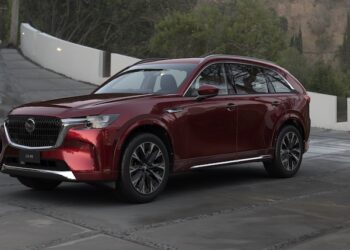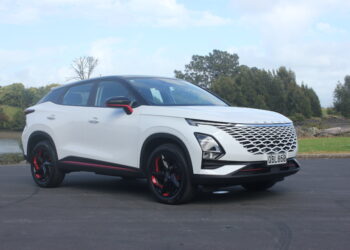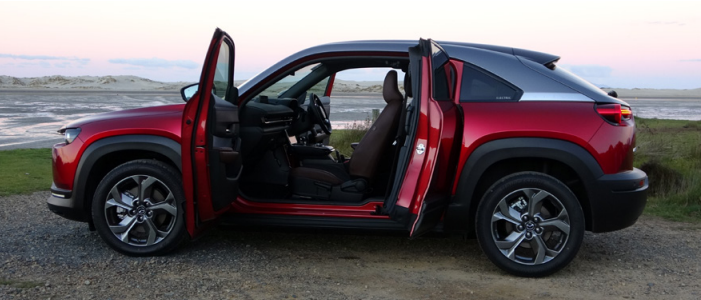
Mazda has finally arrived in the electric vehicle space. And in a big way, with a family-size, purposebuilt EV with lots of range at a value price. Er, no. The new MX-30 Takami is none of those things. It is based on the same platform as the CX-30 SUV, is compact and built in a style that is more fashion than family, and has a 35.5kWh battery that gives it a real world range that will rarely hit 200km. Yes, you heard that right, 200km. And the price? At $74,990 it costs $5000 more than a Tesla Model 3.
Before you scream ‘compliance car’ hear me, and Mazda, out on its thinking behind the MX-30. And remember it is just the first of a series of electric vehicles rumoured to be coming from the brand.
Word on the street is an EV version of the CX-30 is coming, while Mazda is part of a joint venture with Toyota, Subaru and others developing dedicated EV platforms.
So let’s tackle the battery and range. Mazda is pushing that it has studied the full lifecycle of vehicles and their usage, and it believes that a smaller battery has benefits, and the 35.5kWh unit provides an optimum balance between a driving range which gives customers peace of mind and CO2 emissions from an LCA (Life-Cycle Assessment) perspective.
It is an interesting idea, and it makes sense that if users are by and large only ever doing city runs or the occasional short trip on the open road, why bother with the resource, dynamic and efficiency compromises of a big battery?
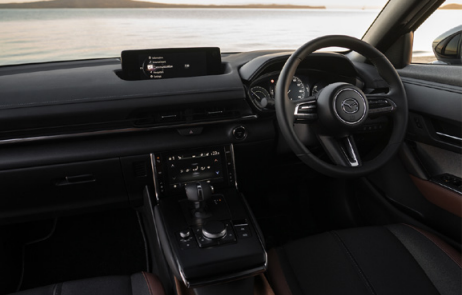
It makes sense, though I would likely agree more with the theory if the car was just a little cheaper. The Nissan Leaf, Renault Zoe, MG ZS EV and Hyundai Ioniq all offer more range for less. It is the one hole in the logic.
Where the Mazda does claw some of the value back is in the quality. The MX-30 is arguably the best built car, to my visual and tactile inspection, in the market. Panel gaps are tight and even, seals tidy, and interior fit and finish surpassing what you would expect from the usual European market leaders. Mazda has taken things to a new level by incorporating materials with green credentials – vegan leather, recycled plastic bottles in the door trim and cork wood trim – sourced by literally peeling a live tree without killing it.
A key talking point of the MX-30 is the rear-opening doors, which while a reminder of the BMW i3 are more closely related to the RX-8 sports car. Space in the front is excellent, this feels like a large vehicle for the front seat passengers. In the rear, things are tight but enough for adults – though the windows are so small it all feels a little closed in.
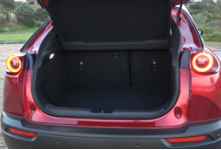
The boot is a modest 366 litres, bigger than a Kona’s but smaller than a ZS EV’s. There is no frunk, though you could just about fit a suitcase under the bonnet – all the electronics fit in a small vertical stack with a dinky plastic SkyActivE cover on it. There looks like suspiciously enough room for a single-cylinder rotary engine range extender…
Jumping behind the wheel is a lovely experience. You sit a little low in the MX-30 and the multi-layer centre console gives it all a bit of a cockpit feel. You get three screens, one in the gauge cluster in front of you, one for the infotainment system (including Apple CarPlay and Android Auto), and a smaller one for climate controls. Sorry, just give me some buttons and dials back here!
The transmission shifter is unique in the EV world in that it is a gated handle, like an old-school automatic. This feels a little odd, and kills my habit with EVs of simply switching them off on arrival and letting the car do the rest.
Drive is to the front wheels only, and you get a modest 105kW of power and 264Nm of torque – line ball with the ZS EV on power but down nearly 90Nm of the latter. Mazda again suggests this is deliberate, it wants a smoother, more efficient drive And it’s oddly not wrong, the lower torque delivery makes for a more relaxing drive, though some will miss the push in the back feel of normal EV progress. The zero-100km sprint takes just short of 10 seconds.
The handling of the MX-30 does feel comfortable and well set up. The ride is smooth and comfortable, it corners flatly and the steering is responsive enough. It is a cruiser rather than a sportster, and that is ok. It is also quiet, very quiet.
Our short test included a 250km mix of urban, motorway and rural roads, and we averaged 17-18kWh per 100km. This required a stop at a DC charger where the technically 50kW-capable car topped out at around 43kW. Still, a small battery means a short charge time. The onboard charger is a 6.6kW unit and this is the first new Japanese EV to land in the country with CCS 2 charging.
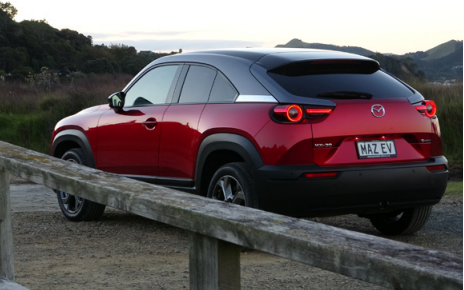
Mazda is throwing in a few extras. A free $2000 WallBox unit will be available to early adopters, while all buyers will get a fiveyear warranty, eight-year battery warranty and five-years of free scheduled servicing.
Every MX-30 sold will also fund the planting of five native trees through Trees that Count.
While the MX-30 will not appeal to all, particularly the EV nerds for whom hard numbers mean everything, for Mazda fans or those who like something a little urbane, a little different, the MX-30 will be a hit. The local distributor has secured 120 units this year, and I suspect they will not be a hard sell.





